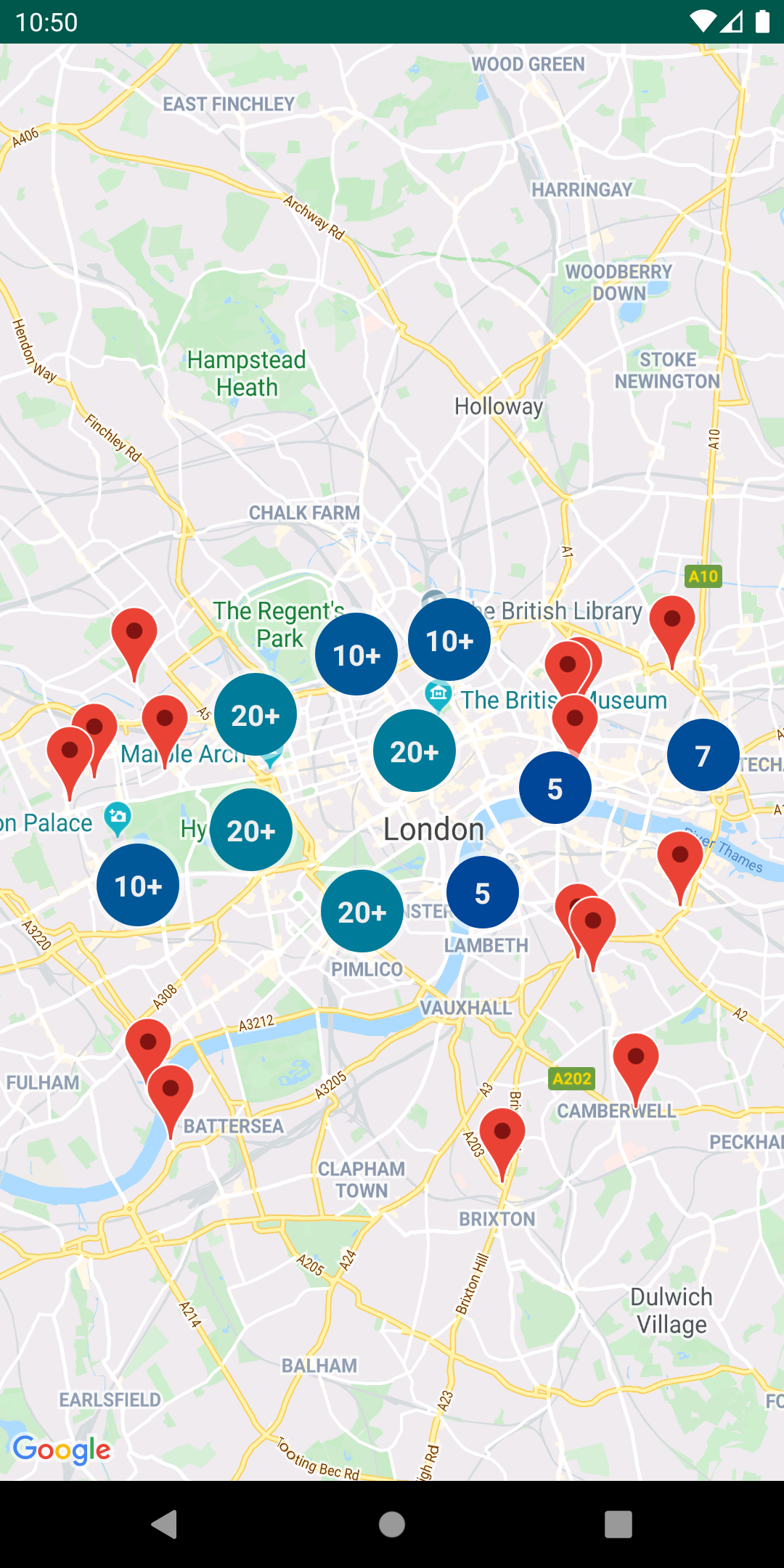Maps SDK for Android Utility Library
Description
This open-source library contains utilities that are useful for a wide range of applications using the Google Maps SDK for Android.
- Marker animation - animates a marker from one position to another
- Marker clustering — handles the display of a large number of points
- Marker icons — display text on your Markers
- Heatmaps — display a large number of points as a heat map
- Import KML — displays KML data on the map
- Import GeoJSON — displays and styles GeoJSON data on the map
- Polyline encoding and decoding — compact encoding for paths, interoperability with Maps API web services
- Spherical geometry — for example: computeDistance, computeHeading, computeArea
- Street View metadata — checks if a Street View panorama exists at a given location
You can also find Kotlin extensions for this library in Maps Android KTX.

Requirements
- Android API level 21+
- An API key
Installation
dependencies {
// Utilities for Maps SDK for Android (requires Google Play Services)
// You do not need to add a separate dependency for the Maps SDK for Android
// since this library builds in the compatible version of the Maps SDK.
implementation 'com.google.maps.android:android-maps-utils:3.8.3'
// Optionally add the Kotlin Extensions (KTX) for full Kotlin language support
// See latest version at https://github.com/googlemaps/android-maps-ktx
// implementation 'com.google.maps.android:maps-utils-ktx:<latest-version>'
}Demo App

This repository includes a sample app that illustrates the use of this library.
To run the demo app, you'll have to:
- Get a Maps API key
- Add a file
local.propertiesin the root project (this file should NOT be under version control to protect your API key) - Add a single line to
local.propertiesthat looks likeMAPS_API_KEY=YOUR_API_KEY, whereYOUR_API_KEYis the API key you obtained in the first step - Build and run the
debugvariant for the Maps SDK for Android version
Documentation
See the reference documentation for a full list of classes and their methods.
Usage
Full guides for using the utilities are published in Google Maps Platform documentation.
Marker utilities
### Marker utilities - Marker animation [source](https://github.com/googlemaps/android-maps-utils/blob/main/library/src/main/java/com/google/maps/android/ui/AnimationUtil.java), [sample code](https://github.com/googlemaps/android-maps-utils/blob/main/demo/src/main/java/com/google/maps/android/utils/demo/AnimationUtilDemoActivity.java) - Marker clustering [source](https://github.com/googlemaps/android-maps-utils/tree/main/library/src/main/java/com/google/maps/android/clustering), [guide](https://developers.google.com/maps/documentation/android-sdk/utility/marker-clustering) - Advanced Markers clustering [source](https://github.com/googlemaps/android-maps-utils/tree/main/library/src/main/java/com/google/maps/android/clustering), [sample code](https://github.com/googlemaps/android-maps-utils/blob/main/demo/src/main/java/com/google/maps/android/utils/demo/CustomAdvancedMarkerClusteringDemoActivity.java) - Marker icons [source](https://github.com/googlemaps/android-maps-utils/blob/main/library/src/main/java/com/google/maps/android/ui/IconGenerator.java), [sample code](https://github.com/googlemaps/android-maps-utils/blob/main/demo/src/main/java/com/google/maps/android/utils/demo/IconGeneratorDemoActivity.java)Data visualization utilities
### Data visualization utilities - Display heat maps [source](https://github.com/googlemaps/android-maps-utils/tree/main/library/src/main/java/com/google/maps/android/heatmaps), [guide](https://developers.google.com/maps/documentation/android-sdk/utility/heatmap) - Import GeoJSON [source](https://github.com/googlemaps/android-maps-utils/tree/main/library/src/main/java/com/google/maps/android/data/geojson), [guide](https://developers.google.com/maps/documentation/android-sdk/utility/geojson) - Import KML [source](https://github.com/googlemaps/android-maps-utils/tree/main/library/src/main/java/com/google/maps/android/data/kml), [guide](https://developers.google.com/maps/documentation/android-sdk/utility/kml)Polyline and spherical geometry utilities
### Additional utilities - Polyline encoding and decoding [source](https://github.com/googlemaps/android-maps-utils/blob/main/library/src/main/java/com/google/maps/android/PolyUtil.java), [encoding sample](https://github.com/googlemaps/android-maps-utils/blob/main/demo/src/main/java/com/google/maps/android/utils/demo/PolySimplifyDemoActivity.java), [decoding sample](https://github.com/googlemaps/android-maps-utils/blob/main/demo/src/main/java/com/google/maps/android/utils/demo/PolyDecodeDemoActivity.java) - Spherical geometry [source](https://github.com/googlemaps/android-maps-utils/blob/main/library/src/main/java/com/google/maps/android/SphericalUtil.java), [compute distance sample](https://github.com/googlemaps/android-maps-utils/blob/main/demo/src/main/java/com/google/maps/android/utils/demo/DistanceDemoActivity.java)Street View metadata utility
### Street View metadata utility The StreetViewUtil class provides functionality to check whether a location is supported in StreetView. You can avoid errors when [adding a Street View panorama](https://developers.google.com/maps/documentation/android-sdk/streetview) to an Android app by calling this metadata utility and only adding a Street View panorama if the response is `OK`. ```kotlin StreetViewUtils.fetchStreetViewData(LatLng(8.1425918, 11.5386121), BuildConfig.MAPS_API_KEY,Source.DEFAULT) ``` `fetchStreetViewData` will return `NOT_FOUND`, `OK`, `ZERO_RESULTS` or `REQUEST_DENIED`, depending on the response. By default, the `Source` is set to `Source.DEFAULT`, but you can also specify `Source.OUTDOOR` to request outdoor Street View panoramas.Migration Guide from v0.x to 1.0
### Migrating from v0.x to 1.0 Improvements made in version [1.0.0](https://github.com/googlemaps/android-maps-utils/releases/tag/1.0.0) of the library to support multiple layers on the map caused breaking changes to versions prior to it. These changes also modify behaviors that are documented in the [Maps SDK for Android Maps documentation](https://developers.google.com/maps/documentation/android-sdk/intro) site. This section outlines all those changes and how you can migrate to use this library since version 1.0.0. ### Adding Click Events Click events originate in the layer-specific object that added the marker/ground overlay/polyline/polygon. In each layer, the click handlers are passed to the marker, ground overlay, polyline, or polygon `Collection` object. ```java // Clustering ClusterManagerContributing
Contributions are welcome and encouraged! See the contributing guide for more info.
Support
This library is offered via an open source license. It is not governed by the Google Maps Platform Technical Support Services Guidelines, the SLA, or the Deprecation Policy (however, any Google Maps Platform services used by the library remain subject to the Google Maps Platform Terms of Service).
This library adheres to semantic versioning to indicate when backwards-incompatible changes are introduced.
If you find a bug, or have a feature request, please file an issue on GitHub.
If you would like to get answers to technical questions from other Google Maps Platform developers, ask through one of our developer community channels including the Google Maps Platform Discord server.


